
US Postage Stamps
// Philatelic Project
// The Federal States



| District of Columbia // Middle Atlantic Region // Eastern Time |
|
The nation's federal district was created on July 16, 1790
with land donations from Maryland and Virginia, which included the preexisting settlements of Georgetown, MD, and Alexandria, VA. |
|
By an act of the US Congress on July 9, 1846 the area south
of the Potomac River was returned to Virginia effective in 1847. |
|
The Federal District is under the exclusive jurisdiction of the
US Congress and is therefore not part of any US Federal State. |
|
Washington, DC
The national capital of the United States of America was established on July 16, 1790. On June 11, 1800, Washington, DC, became the permanent capital of the USA. The US Congress held its first session in Washington, DC, on November 17, 1800. |
| [View related maps] |
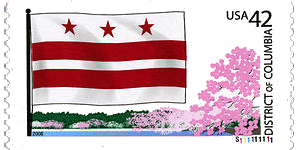
|
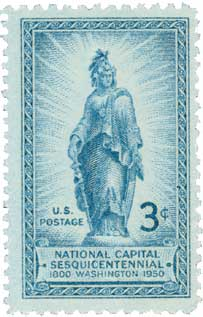
|

|
||||
|
#4283 // September 2, 2008
(self-adhesive coil definitive) Flags of Our Nation Series
District of Columbia Flag
and blooming cherry trees |
#989 // April 20, 1950
National Capital Washington, DC Sesquicentennial
Statue of Liberty atop
the Dome of the Capitol |
#990 // June 12, 1950
National Capital Washington, DC Sesquicentennial
Executive Mansion
White House |
||||
|
||||||
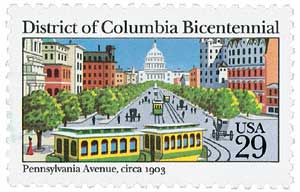
|
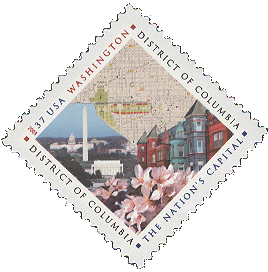
|
|
#2561 // September 7, 1991
District of Columbia Bicentennial Capitol Building from Pennsylvania Avenue, ca. 1903 |
#3813 // September 23, 2003
District of Columbia District Map, National Mall, Historic Houses, and Cherry Blossoms The stamp was issued in response to protests from Washington, DC's absence from the "Greetings from America" 50-stamp set. |
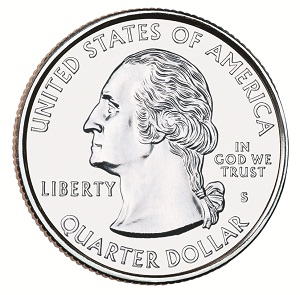
|
View District of Columbia state quarter
View District of Columbia clock |
||
|
|
The Federal District of Columbia was named in honor of
Christoph Columbus (*1451, † 1506), the rediscoverer of the American continent in 1492.
The District has the smallest land area (61 mi2) and the
highest population density/mi2 (9,856) in the United States; 51% of the residents are African Americans.
The newly built national capital was officially named on September 9, 1791,
"Washington" in honor of George Washington (* 1732, † 1799), first President of the USA (in office April 30, 1789 - March 4, 1797). |
||
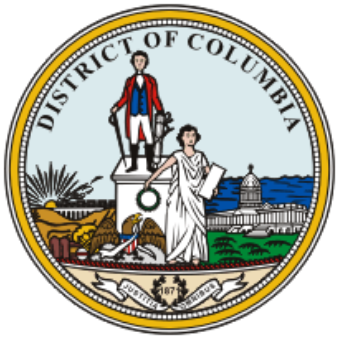
|
Land Area
rounded mi2 [km2] 61 [158] ranked 51st |
Population
(census 2010) 601,723 ranked 50th |
Population Density
per mi2 [km2] of land area 9,856 [3,808] ranked 1st |
|
For statistical purposes the District of Columbia is considered both
a state-equivalent and a county-equivalent. |
|||
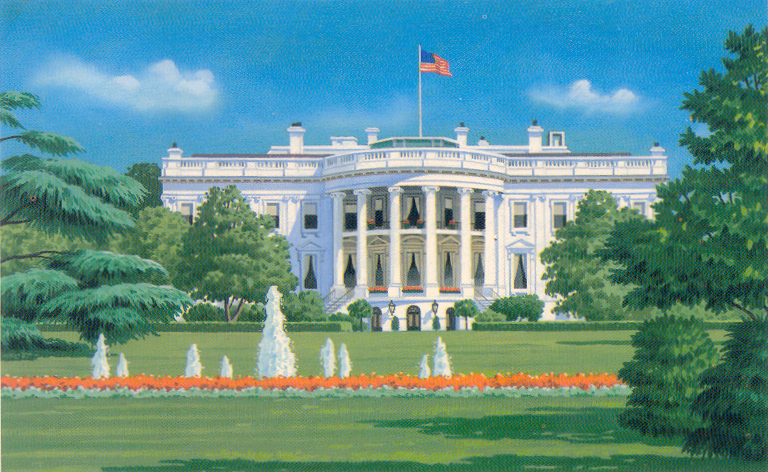
|
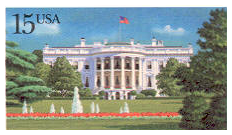
|
|
#UX143 // November 13, 1989 // Washington, D.C.
Stamped Photo Postal Card The White House 1600 Pennsylvania Ave NW, Washington, DC 20500 |
|

|

|
|
#UX144 // December 2, 1989 // Washington, D.C.
Stamped Photo Postal Card Jefferson Memorial 900 Ohio Dr SW, Washington, DC 20242 |
|

|
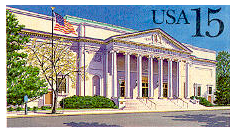
|
|
#UX151 // October 11, 1990 // Washington, D.C.
Stamped Photo Postal Card Daughters of the American Revolution (DAR) Centennial Memorial Continental Hall 17th St., between C and D Sts., NW, Washington, DC 20006 (photo at left) Constitution Hall 1776 D St NW, Washington, DC 20006 (imprinted stamp at right) |
|

|
|
#UX99 // April 19, 1983 // Washington, D.C.
Stamped Postal Card Old Post Office and Clock Tower 1100 Pennsylvania Ave NW, Washington, DC 20004 |
| Originally built between 1892/1899 by American architect Willoughby J. Edbrooke (* 1843, † 1896) in Richardsonian Romanesque style. In 1973 the Old Post Office was added to the "National Register of Historic Places". Extensively renovated in 1976 and officially renamed in "Nancy Hanks Center" in 1983, in honor of Nancy Hanks (* 1927, † 1983), first female chairman (1969 - 1977) of the "National Endowment for the Arts (NEA)". |
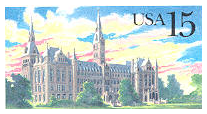
|
|
#UX128 // January 23, 1989 // Washington, D.C.
Stamped Postal Card Historic Preservation Series National Historic Landmark Healy Hall, Georgetown University, Washington, D.C. |
| The University of Georgetown, a historic neighborhood of Washington, DC, was founded in 1789 by John Carroll (* 1735, † 1815), America's first Catholic bishop. Healy Hall is the historic flagship building at the main campus of the university. It was constructed between 1877/1879 and designed by the architects Paul J. Pelz (* 1841, † 1918) and John Smithmeyer (* 1832, † 1908) in Flemish Romanesque style with elements of Barockque. The building was named after the Jesuit priest Patrick Francis Healy (* 1830, † 1910), the 29th President (1873 - 1882) of Georgetown University. |
| // Elmar R. Göller // All rights reserved // Contact // Publishing Information |
| modified |